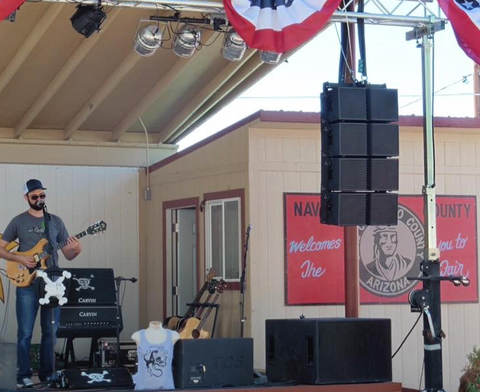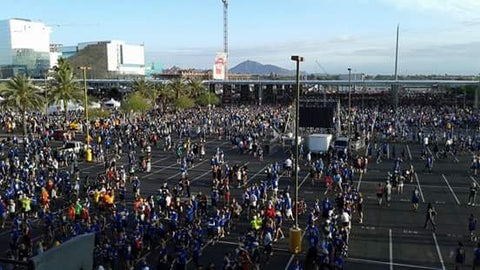-
Audio
-
Guitar
-
Bass
-
Blog
-
SALE
- Financing
- Support
- SINCE 1946
August 12, 2016
I am frequently asked “which are better, active or passive speakers?” The short answer is “Neither.” The real answer is dependent on many variables. My production company currently has inventory of both active and passive speakers. We use both very frequently and often at the same events. Here are a few ideas that you might consider when choosing between active and passive speakers.

We frequently use both active and passive speakers at the same events such as the active line array and passive subwoofers and monitors shown here.
Passive Speakers: Advantages
Let’s first take a look at some of the benefits of passive speakers. The number one, biggest advantage of passive speakers is power and signal distribution. You do not need to run power cables to each of the speakers, just a speaker cable. This is very handy as it saves you time and labor while running your cables. There are about half as many cables to run for a basic sound system. Generally you only need run power to your amplifier racks.
The second advantage with passive speakers is the processing control the user can implement with them. Using modern amplifiers with integrated loudspeaker controllers such as the Carvin Audio DCM3800LX, the user can use factory presets, modify these presets or create new presets for their speakers, and optimize them for a particular room or stage.
Passive Speakers: Disadvantages
Along with these advantages, passive speakers have one big drawback - the need to carry amplifiers to power them. A typical small sound system may consist of two subwoofers, two main speakers and four monitors. This requires a lot of amplifiers to properly power them. At minimum you need one amplifier for the two main speakers, one amplifier for each subwoofer and several amplifiers for the monitors. A typical amplifier rack with five amplifiers can weight close to 200 lbs (tour grade road cases with light amps are still heavy) and take up approximately four square feet of truck space.
The second disadvantage comes when we need to daisy chain passive speakers together. Most modern amplifiers will run down to minimum loads of 2 ohms per channel. Under a best case scenario we can run up to four typical 8 ohm speakers per channel on a 2 ohm per channel amplifier. As you add speakers, speaker cables, and connections to this chain of speakers, the resistance begins to build up and we get less output from each of the speakers. It is important that you don’t turn up too loud to compensate for these losses as you risk distorting the signal and deteriorating your audio quality. None the less, the amplifier may be able to put out 1800 watts, but the last speaker of the four is not getting its full 450 watt share.

This concert system of passive speakers uses 10 amplifiers split between two amplifier racks
Active Speakers: Advantages
Looking at the benefits of active speakers you begin to see that they are very useful. The biggest benefit that my company gets from active speakers is the convenience of not having to carry additional amplifier racks. We implement active mains, subwoofers and monitors to fill a wide range of events. For our company, a typical event with passive speakers will use two to four amplifier racks, each weighting close to 300 lbs. We can save close to 900 lbs from our load (and backs) by leaving three amp racks in the shop, and using active mains and monitors. For smaller events where our inventory of active subwoofers will fulfill the event’s needs, we do not bring any amp racks to the event.
Another big advantage of active speakers is their ability to daisy chain together for wide area coverage such as 10K runs, car shows, air shows and parade routes. We can run signal cable to each of the speakers or even send the signal wirelessly with the use of an in-ear monitor system or other wireless system. Due to the low current draw of most active speakers, you can easily run several of them from a single 20 Amp circuit. This makes since, because the amp that would run several passive speakers would be run from one 20 Amp circuit also.
This is our typical speaker setup for parade routes and air shows. Holds two active speakers and covers 180° of area.
Lastly, another great advantage of active speakers is the sound quality. High end active speaker systems have presets the speaker designer creates to optimize the sound quality and performance of the individual components in the speaker. The user gets more consistent sound from gig to gig, because the tough work of optimizing the system has already been done by the manufacturer. This is an incredible advantage!
Active Speakers: Disadvantages
There are three major disadvantages to active speaker systems. The first is with regards to power distribution. We need to run power to each of the speakers. This means running a power cord to each location in addition to the signal cable, so in effect we are running twice the number of cables. While we save space and weight in the truck with the use of the active speakers, we still need to carry the extra cables which generally take up a couple square feet in the truck.

We use 20 active speakers and active subwoofers to cover over 30 Acres.
The second disadvantage of active speakers is when running lots of them daisy chained together. With the use of some microphone cables marketed as being “better” at rejecting noise due to having quad cables twisted inside of them, there is a higher capacitance inherent in the cable. Adding too many of these together increases the capacitance and the linked cables become a low pass filter, cutting the high frequencies from the signal. When running several active speakers together, it is important to use microphone cables that are not of the quad twist variety to lower this phenomenon.
Due to the high quality of active loudspeakers and amplifier modules such as those used in the Carvin Audio TRX3210A and TRC column systems the last disadvantage is much less likely to affect the user. If for some reason you have an amplifier module stop working (a performer dumps their drink in the module), you essentially lose a speaker completely, unless you have a spare amplifier module. With a passive speaker system you can daisy chain off another passive speaker, if you lose an amp channel, and limp through the gig.
So which is better, active or passive? I continue to think of both as tools that we use to do our job, and both work well within their design parameters. My company continues to add active speaker systems to our inventory as I feel the advantages of active speakers far outweigh the disadvantages for our business model, and they provide a much higher return on our investment than passive speaker.
About the Author:
Ryan Jenkins started providing audio services in 1989. His production company, Concert Sound Solutions, provides productions for events throughout the Southwest United States. They currently have many Carvin Audio speakers in their inventory in addition to passive and active speakers from other top manufacturers.
November 11, 2025
"This Is An Underrated Sound System!" DJ Tech Tips reviews the Carvin Audio TRC400A 4000W Powered Column Array System in this video.
October 13, 2025
Carvin TRC Active Column Array System features and setup video. Watch this video to discover the features and benefits of our active column array sound system. TRC Powered Column Array Systems offer portability with high SPL levels that project up to 400’ with exceptional clarity. Unsurpassed high frequency and deep bass response will place the audience in the center of your performance. TRC Systems are scalable and are available in 2000W, 4000W, and 8000W models.
June 18, 2025
Carvin Audio teams up with Red Bull to provide audio for the VIP experience in Des Moines for the 2025 Soap Box Race Iowa. The TRC Active Column Array System was used for the event.
Sign up to get the latest on sales, new releases and more…
NoFraud Frequently Asked Questions
"Make a joyful noise unto the Lord all of the earth; make a loud noise and rejoice and sing praises. Sing to the Lord with the harp and the voice of the psalm." - Psalm 98:4-5
© 2025 Carvin Audio.
Carvin Corp.
POS and Ecommerce by Shopify
